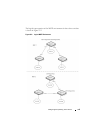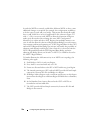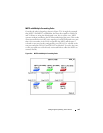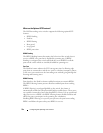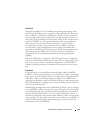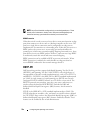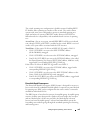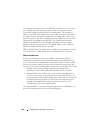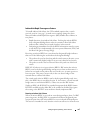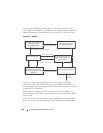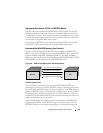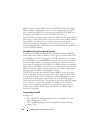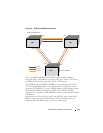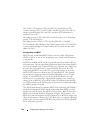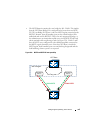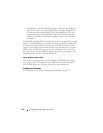
Configuring the Spanning Tree Protocol 727
IndirectLink Rapid Convergence Feature
To handle indirect link failure, the STP standard requires that a switch
passively wait for “max_age” seconds once a topology change has been
detected. IndirectLink Rapid Convergence (IRC) handles these failures in
two phases:
• Rapid detection of an indirect link failure. Tracking the inferior BPDUs
that a designated bridge detects when it transmits a direct link failure
indicates that a failure has occurred elsewhere in the network.
• Performing an immediate check if the BPDU information stored on a port
is still valid. This is implemented with a new protocol data unit (PDU) and
the Root Link Query message (RLQ).
Receiving an inferior BPDU on a port from the designated bridge indicates
that one of the following has occurred on the designated bridge:
• The path to the root has been lost and the switch starts to advertise a root
with a numerically higher bridge ID (worse root) than the local switch.
• The path cost to the root has increased above the path cost of the local
switch.
IEEE 802.1s behavior is to ignore inferior BPDUs. IRC retains the inferior
BPDUs sent by the designated bridge and processes them to determine if a
failure has occurred on the path to the root. In this case, it must age-out at
least one port. This process occurs only in the case that a bridge in the
network detects a direct link failure.
The switch tracks inferior BPDUs sent by the designated bridge only, since
this is the BPDU that is stored for the port. If, for instance, a newly inserted
bridge starts to send inferior BPDUs, it does not start the IRC feature.
Similar to DRC, the IEEE 802.1w standard incorporated the IRDC feature.
RSTP-PV enabled switches allow IRC to be enabled or disabled, but ignore
the setting as the RSTP-PV state machines already implement IRC.
Reacting to Indirect Link Failures
When an inferior BPDU is received on a non-designated port, phase 2 of IRC
processing starts. An RLQ PDU is transmitted on all non-designated ports
except the port where the inferior BPDU was received and self-looped ports.
This action is intended to verify that the switch can still receive from the root



